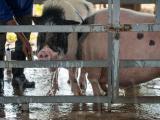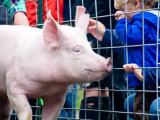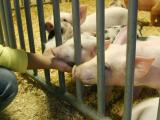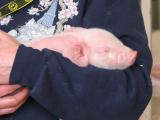Jan 27, 2012 (CIDRAP News) – Canadian researchers have reported a study in which both young children and middle-aged adults had little evidence of immune protection against swine-origin influenza H3N2 viruses like those that have been reported recently in a dozen US children.
The study showed that young adults had antibodies against the viruses, but antibody levels waned in middle-aged people. The study also indicated that the seasonal flu vaccine yielded little protection against the swine strains.
Flu experts have said that people older than about 20 should have some protection against the swine H3N2 viruses, because similar viruses were circulating in humans in the 1990s. The new report suggests this may not be true for middle-aged people. People older than 59 were not included in the study, but the researchers said the age-related drop in protection raises concerns for seniors, who are more vulnerable to serious H3N2 infections
The group undertook the study to see how vulnerable different age and vaccination-status groups are to emerging swine H3N2 viruses, given the sporadic cases that have been reported in Canada and the United States, as well as 12 recent US cases that involved a novel H3N2 strain that includes the M gene of the 2009 H1N1 virus. They published their findings yesterday in Eurosurveillance.
The team used serum samples from adults and children that had previously been collected for an immunogenicity trial of the 2010-11 seasonal flu vaccine, which contained the same three flu strains as this season's vaccine. They tested the samples against a seasonal H3N2 strain (Wisconsin/15/2009) that is similar to the H3N2 component of the seasonal flu vaccine, a swine H3N2 virus collected from a sick ferret that had been housed with swine at a research facility, and a human ancestor of a swine H3N2 (Sydney/5/97).
Dr Danuta Skowronski, a physician and epidemiologist with the British Columbia Center for Disease Control and first author of the study, told CIDRAP News by e-mail that the ferret virus they used was a surrogate for swine-related H3N2 viruses, including the novel strain. She said the group was eager to begin the risk assessment and hence used a more readily available representative virus. "While it is not a precise match, it is useful for demarcating major age-related patterns expected with swine-origin H3N2 viruses, all of which are descended from a common ancestral human influenza virus that circulated about 15 years ago," she said.
To frame the interpretation of the swine H3N2 age-related findings, the researchers also used Sydney/5/97 to represent the ancestor virus and Wisconsin/15/2009 to represent recently circulating human H3N2 viruses. Skowronski said the group hypothesized that the human ancestor virus would probably play a role in age-related cross-protection patterns, and using it in the study allowed researchers to get an initial glimpse of age-related similaries and differences.
The study included blood samples from 138 children, who ranged in age from 17 to 120 months. Eighty (58%) had received at least one dose of seasonal vaccine. Samples from 65 adults were included in the study, with an age range of 20 to 59 years. Most (89%) had received a flu vaccine.
Using influenza gene databases, the researchers analyzed relationships between the hemagglutinin and neuraminidase proteins of the ferret virus, one of the US novel H3N2 variants, called H3N2v, and other human and swine H3N2 isolates, as well as the seasonal flu vaccine components.
The immunogenicity and cross-reactivity analyses found that only 1% and 12% of children, but half of adults, had hemagglutination-inhibition (HI) antibody titers of 40 or more to the ferret and Sydney strains. Antibody titers to these two strains rose only marginally after vaccination in both children and adults.
About 35% of both adults and children had HI titers of 40 or more to the seasonal flu isolate, and these levels rose substantially after vaccination.
Titers to all three strains increased with age in children both pre- and post vaccination. In adults, however, titers decreased significantly with age for the ferret and Sydney strains, though not for the Wisconsin strain. Specifically, protective levels of antibodies to the ferret and Sydney strains were significantly less frequent in adults 40 to 59 years old than in those aged 20 to 39.
The authors note several limitations of their study: antibody assay results may vary among labs, the HI assays may not represent functional antibodies, and the HI threshold of 40 may or not may not predict immunity to zoonotic infections.
A specific swine-related H3N2 virus hasn't achieved sustained community transmission, and it's difficult to predict which one might jump to humans, the report says. "For the purpose of ongoing risk assessment, it thus remains prudent to consider major trends rather than precise results for a particular swH3N2 virus," it states.
The researchers said their findings concerning the lack of cross-protection provided by the 2010-11 vaccine likely apply to the current season's flu vaccine, since it targets the same three flu strains.
The unexpected decrease in cross-reactive antibodies with age in adults should be investigated in more detail, because it suggests low antibody titers in older people, which might have clinical implications, the authors write
Skowronski said more work needs to be done to test their hypothesis in interpreting the adult findings, which are preliminary and consistent with the concept of original antigenic sin, which predicts strong and preferential recall of antibodies to the first-infecting virusus encountered during childhood with subsequent influenza infections across the lifespan.
"Young adults are more likely to have had the priming exposure with the ancestral A/Sydney-like virus in their childhood, and it may be that this explains the higher titers in young but not older adults," she said, adding that more detailed investigations are needed.
Overall, the findings suggest that young children have broad susceptibility to swine-origin H3N2 viruses, which is consistent with the epidemiologic pattern seen in the US H3N2v cases, the report says. Since older adults are more vulnerable to severe H3N2 infections, the patterns that emerged in the study should prompt more studies to guide risk assessment and response to emerging swine-origin H3N2 viruses, the authors say.
Given that the seasonal flu vaccine conferred little cross-protection, the group said the findings point to a need for a specific candidate vaccine to curb the spread of a potential swine H3N2 epidemic.
Skowronski DM, De Serres G, Janjua NZ, et al. Cross-reactive antibody to swine influenza A (H3N2) subtype virus in children and adults before and after immunization with 2010/11 trivalent inactivated influenza vaccine in Canada, August to November 2010. Eurosurveill 2012 Jan 26;17(4) [Full text]
See also:
Dec 23, 2011, CIDRAP News story "CDC reports two more novel flu infections"


















